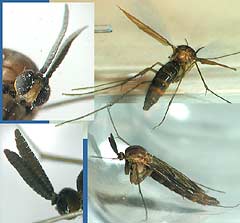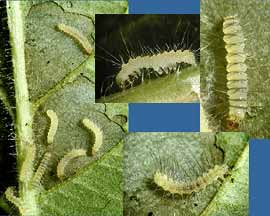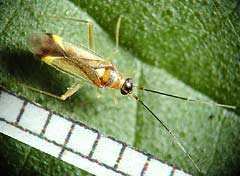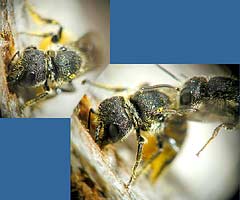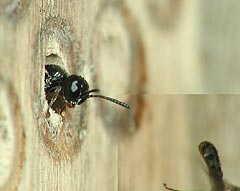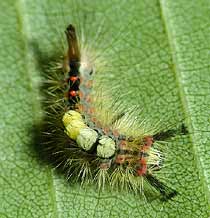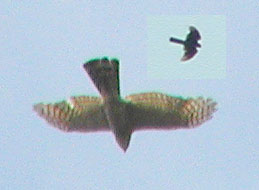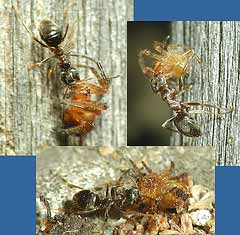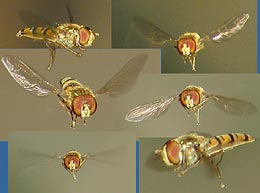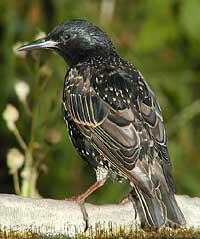Go to last entry.......................................Go to previous entry1 July - Today is turning into one of warm sunshine and the threat of showers as dark clouds pass overhead. There seem to have been less mosquitoes around this year so far. I've only encountered the type that gives be most grief (Culiseta annulata) a couple of times and these have not survived long enough to either bite me or get their portraits taken.
The piercing mouth parts (proboscis) of the bug consist of a pair of very thin tubes called stylets which sit in a grove surrounded by a protective labium. One of the tubes is used to pump saliva down into the plant or animal, and the other draws up the liquid food.
In the top image (see the larger version) you may just make out how the top section of the labium has folded back towards the rear to expose the darker coloured stylets, the lower end of which are penetrating my skin! Last year, the last week of June saw the first appearance in my garden of a Wild Chamomile, also called Scented Mayweed (Matricaria recutita). This year it has appeared again, this time half-hidden under the caravan. I'm not sure when the first flower opened, but it must have been in the last couple of days.
This meant that the solitary bees were not active. However, this afternoon it warmed up a little bit, enough to encourage a couple of the leaf-cutter bees to emerge for the first time. The top and left images show the first one seen to emerge. It appeared at the end of the bamboo tube with a large chunk of 'old' leaf and fell straight down. They landed on a fern frond where the bee rested for about five minutes before flying off for the first time. The lower-right image shows the second bee looking out past strands of spider silk. After resting there, it emerged, climbed along other silk threads and made its way to the top of the framework before it too took its first flight. I didn't see either of them return, and a check of the tubes this evening shows just one leaf-cutter bee (the one pictured on 28 May) in residence.
4 July - Well, with summer suspended for the last couple of days it has been cool enough to put the shorts away, and yesterday's evening meal was the first one indoors for several weeks! However, there is a good percentage of blue sky this morning so I shall be optimistic for today. This large midge came into the house last night. It was not an attractive character but its flattened antennae on a relatively tiny head made it interesting enough to justify a few photographs before it was released outside. It measured 14-15mm in length, each wing being about 10mm long. Looking in my insect guides doesn't come up with an exact match but it looks as though it belongs to the Mycetophilidae (fungus gnats).
It remained dry all day, although mostly cloudy. There were glimpses of sunshine, and during one bright spell we had a visit from a butterfly - a Fritillary, although I could not get close enough to photograph it, or identify it properly. As a sort of consolation, I spotted these caterpillars, each measuring about 4mm (stretching to 5mm) on the Elder. The left-hand image shows the extent of their browsing this far, on the underside of a leaf. The top-centre image shows the normal arrangement of legs that distinguishes these from sawfly larvae. One of them (top right) seemed to have more obvious dark banding, although I assume they are all the same species.
At the end of May I noted the first flowering on our surviving Valarian (Valeriana officinalis) plant which is next to the Elder. Today, while there are still flowers on the plant, I noticed the seed heads that are now being produced. The 'parachutes' are up to 10mm across.
Up to now, larger fungi have been noticeable by their absence, but this one has popped up in the grass by the small pond. The cap measures about 28mm across. Needless-to-say, I'm having a problem identifying it, although I think it may be one of the Cortinarius species.
6 July - More butterflies today, with a Red Admiral, a Large White and, probably a Holly Blue avoiding my camera!
I think it is a Campyloneura virgula, which feeds on Aphids, other small insects and red spider mites.
At the end of June I photographed one of the flies that is a constant companion of the Ragwort flowers as they develop. The flies appear to be laying eggs on the buds, but as yet I haven't seen any larvae. However, as the flowers open it is obvious that nearly all of them have some damage, which appears as darker, orange areas in the disc of florets.
Yesterday afternoon the blackbirds were extremely agitated by something in the neighbourhood and kept up their panic calls for a long time. I have no idea what caused their distress but when I went down to behind the Leylandii to check for cats I spotted a very wobbly fledgling high up in the branches. I assume this is a recipient of much of the food the adults have been taking away over the last couple of weeks. When the panic was over the parents took raisins away again. The Song Thrush still takes raisins away, although I only saw it do this once today. Every evening we hear the Song Thrush living up to its name in the trees of the Brickfields Country Park, but this evening we had a rare treat when it spent about ten minutes singing 'on our doorstep'. It was perched at the top of a tree at the bottom of our garden, facing into the setting sun and producing a glorious sound.
There are Sparrowhawks about again now. One pounced on the occupants of the Hawthorn this morning, and I saw one on patrol high over the house this afternoon. As I watched it I spotted a second one circling at about the same height further up the street - it's very unusual to see two at the same time!
8 July - A dull but warm and humid (for us in the UK) day. Although I spent did not do much in the garden, I did spend time watching the solitary bees this afternoon. Several of the '3mm' bees were sealing the entrances of holes while others continued to bring pollen. One piece of behaviour has intrigued me. While the bees are coming and going I often see flying bees 'buzz' one that has landed and fly of without landing. While I was taking more close-ups of a bee busy sealing a hole I didn't notice the second bee (still flying) as it touched the busy bee. It was only as I looked through the images afterwards that I found that I had captured the moment!
While most of the holes I drilled in the old wood are now sealed, or at least occupied by these bees, they seem reluctant so far to visit similar sized holes in a block of newer hard wood I put up next to the old wood. However, this block has attracted the attention of a small wasp that is in a 3mm hole tonight. My first attempts at getting a photograph have resulted in getting these two incomplete images this evening. The wasp is all black and has a slender abdomen that tapers to a very narrow waist. A look in my insect guide suggests that it could be similar to Trypoxylon figulus, a species that can nest in woodworm holes and catches small spiders to stock the cells it constructs for its offspring. On the bird front, things are going on as 'normal' with the blackbirds and the Thrush still taking away raisins, and I saw another Sparrow fledgling being fed today. A Sparrowhawk swooped through the garden this evening, but didn't stop and I think some of the birds here didn't even notice it. The Song Thrush hasn't repeated it performance here but there have been prolonged Greenfinch 'songs' from the tree tops. I forgot the leaf-cutters - As we sat outside this evening I saw a couple of 'debris slides' as fragments of old dry leaves were pushed out of bamboo tubes as a couple more of the bees emerged and started clearing the tubes for the next generation.
9 July - Although I see that the maximum temperature recorded today at Farnborough airfield was 27C, all three thermometers in my garden agreed that it past 30C in the sheltered conditions here - and it was very humid.
There were no others about, but it may be in another of the holes this evening (or may be a bee!). The bees were extremely active today and I spent a bit of time drilling a lot more 3.5mm holes in the block being used by them. They seemed to ignore my use of the drill and some of the new accommodation is already occupied.
The caterpillars pictured on 4 July have disappeared. They may have distributed themselves over the Elder, but I cannot see any signs of leaf damage. This caterpillar was found on the underside of a leaf on the Birch tree this evening. I think it is the larva of the Vapourer Moth (Orgyia antiqua).
The first 'flying ants' made an appearance during the hottest part of the day.
This evening there are females, now without wings, dashing about looking for a suitable place to start a new colony. On the other hand, the males (bottom-left), still with their wings, are lying dead all over the place.
There is no larger version of this picture. It shows a Sparrowhawk riding a thermal higher and higher above the garden shortly after it swooped on the Hawthorn in an unsuccessful attack this afternoon.
11 July - The weather continues good with it warm (27C) this afternoon - yesterday topped 30C again.
Taking these pictures was a bit hit and miss as the ant was definitely in a hurry. It reminded me of the picture I took of an ant in similar circumstances back in May last year when the ant had caught a live parasitic fly in the same place. Those flies, which invaded the bee burrows have been absent so far this year.
It was as though it was using the beams of light as a 'web'. It hovered, turning frequently and then darted at anything that crossed through the threads of sunlight. Notice how it holds the four front legs tucked in and pointing forward. I assume that these are held ready to grab at prey. Every-so-often it would dangle all six legs as though resting them for a moment. The images aren't as sharp as I would have liked, and are cropped from larger originals, but they are the closest I have got yet to succeeding in the challenge set by these little flies! Many of the pictures were empty as the camera's shutter delay and the hoverfly's rapid movement combined to thwart my efforts! Bird activity has started to quieten down now and only the female Blackbird seems to be taking any food away. The Song thrush hasn't appeared at all today, although I've heard its song. I'm not seeing any more Sparrow or Starling fledglings at the moment, although the male pictured last month still sings from the nest box - he was calling loudly from one this morning. I cannot remember when I last took a photograph of a Starling so here's one taken this morning.
There have been fewer butterfly sightings today, although I should have mentioned earlier that yesterday evening, as Sheila and I sat outside, a Comma butterfly landed on our concrete driveway. That is an unusual sighting for our garden. There was also a Holly Blue seen in addition to several Large Whites, but still no photographs.
|
|



